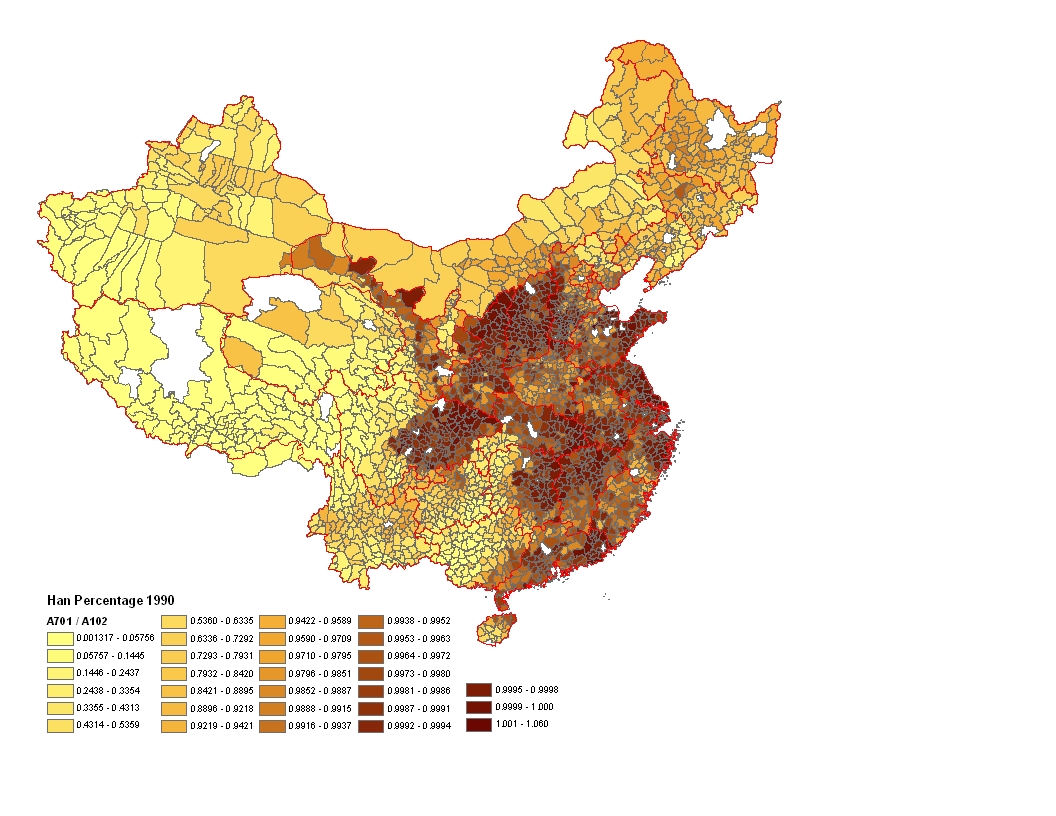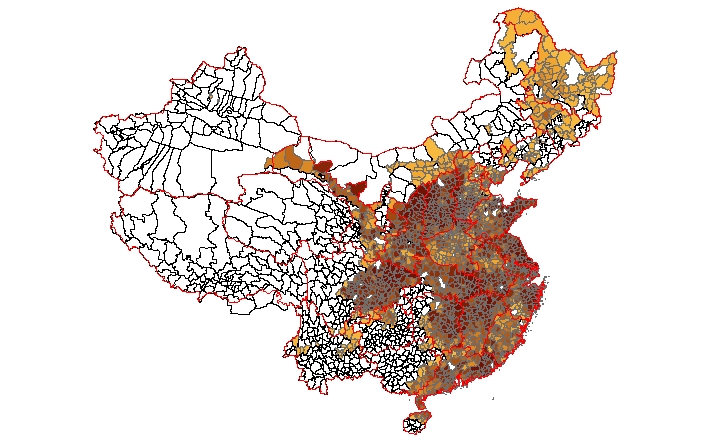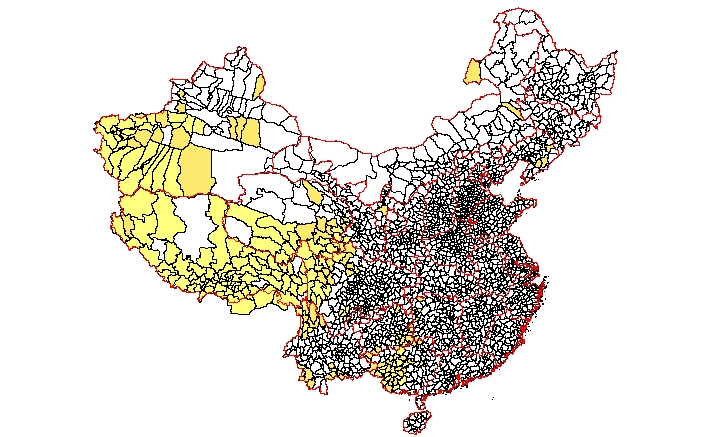

This map took some fiddling around to produce, but it tells some interesting tales. The 1990 census reports that 91.96% of China's population are Han... and so only 8% belong to the 55 other named minzu Minorities. This map shows the counties in China with more than 90% 'ethnic Han' population:
and here's one showing counties where Han are less than 25% of the population:
...but what is Han? And, for that matter, what are the definitions and constituents of the other minzu?
What are these identities, how are they expressed and maintained, and what do they betoken for China? These are not idle questions for us, for the Chinese, or for anthropology. Can we assume that Han identity is in some sense homogeneous, and if so, in what sense? We certainly know that there's a great deal of linguistic variation: a Cantonese speaker is simply incomprehensible to a speaker of Shanghainese, or a Hakka, unless both use the standard national language ('Mandarin')...
Gladney: "It is the cultural difference between Mandarin and Cantonese, Shanghainese and Sichuanese, that most Chinese feared would pull China apart, and the notion of the Han was one fiction encouraged to hold them together." (1994:99)There are plenty of other dimensions of variation, not least genetic and cultural.
(For some of the genetics evidence, see The Chinese Human Genome Diversity Project (L. Luca Cavalli-Sforza PNAS vol. 95, Issue 20, 11501-11503, September 29, 1998) and Genetic relationship of populations in China (J. Y. Chu et al., PNAS vol. 95, Issue 20, 11763-11768, September 29, 1998 --see also its citers via Web of Science), and also Population structure and history in East Asia (Yuan-Chun Di et al, PNAS December 5, 2000 vol. 97 no. 25 14003-14006 --see also its citers via Web of Science))...and for the more 'cultural' side, see National Questions and National Answers in the Chinese Revolution; Or, How Do You Say Minzu in Mongolian? (Christopher P. Atwood, from Indiana East Asian Working Paper Series on Language and Politics in Modern China, ), and Representing Nationality in China: Refiguring Majority/Minority Identities (Dru C. Gladney, Journal of Asian Studies Vol. 53, No. 1, Feb., 1994 pp. 92-123 --the first page quotation is worth the price of admission all by itself)
I did some work on the Miao and found lots of material I want to follow up on sometime.
So the 'minzu' classification of ethnicities is an artificial and political creation, but it's still interesting and useful to look data. We see BOTH a southward flow of 'Han' people, AND a process of 'Sinification' of non-Han peoples. And indeed the Han have a very long recorded history of their dealings with various "barbarians", who were divided into "raw" (sheng) and "cooked" (shu) "according to whether they were cultured enough to accept moral edification and eventual civilization." (Harrell 1995:19).
From Li Chi, ca. the end of the Chou dynasty, describing the surrounding peoples. Note the Four Directions:
The people of those five regions --the Middle states, and the Jung, Yi (and other wild tribes around them)-- had all their several natures, which they could not be made to alter. The tribes on the east were called Yi. They had their hair unbound, and tattooed their bodies. Some of them ate their food without its being cooked with fire. Those on the south were called Man. They tattooed their foreheads, and had their feet turned toward each other. Some of them ate their food without its being cooked with fire. Those on the west were called Jung. They had their hair unbound, and wore skins. Some of them did not eat grain-food. Those on the north were called Ti. They wore skins of animals and birds, and dwelt in caves. Some of them did not eat grain-food. (quoted in Chang The Archaeology of Ancient China pg. 368 [DS715 .C38 1983])
After 1949, efforts were made to consolidate the nation, including establishment of regional autonomy (since everything couldn't be controlled from the center). More than 400 'ethnic groups' registered themselves, "all claiming status as separate nationalities; the province of Yunnan accounted for more than 260 of these" (Schein), and for the next 10 years or so, Chinese anthropologists researched the claims to status as distinct nationalities (and thus potential autonomy) within China.
Schein again: "In Yunnan in the 1970s the twenty-one officially recognized minzu themselves claimed 130 ethnic names, while they had 157 ethnic names given to them by neighboring groups..." (2000:85-86)
...so now there's what amounts to a "Minzu industry" (Schein): "...the flourishing of all manner of reworked or invented ethnic festivals", and efforts to create tourist destinations. A number of Web sites pander to this... but it's been going on for a very long time... if I had time to develop it, I'd make some scans from the Miao albums to exemplify (see Hostetler 2001).
another thing to get to: 100-odd years of Christian missionary activity among Minorities...
Human Relations Area Files:
We have a truly wonderful resource to play with, though it's not all that much use for most of you in terms of projects for Anth230 (only Okinawans, Koreans, and Taiwan Hokkiens are included in the available societies)... still, you should know about it.